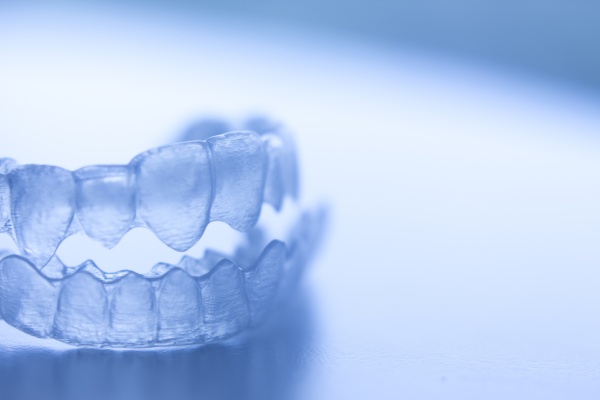Truths and Myths About Invisalign Aligners

Similar to braces, Invisalign® aligners are a type of treatment used to straighten teeth. This procedure uses a series of plastic aligners that are changed every two weeks to achieve the desired results. It is becoming a popular option, but there are a lot of misunderstandings about it. Here are the facts and some of the most common myths surrounding this treatment.
The truths about Invisalign®
These aligners are customized to fit each individual patient’s mouth. Patients receive a series to wear during the course of treatment. Each aligner targets certain teeth to move them until the desired result is achieved. The aligners offer more flexibility than standard braces due to the ability to remove them.
The aligners are made from a clear plastic so are nearly invisible. It is important to wear the devices for around 20 to 22 hours a day, but they can be taken out to eat and drink. Most patients finish treatment in the span of a year or so and results are long lasting, providing a proper retainer is worn after treatment ends to prevent teeth from shifting back.
Common myths about Invisalign®
There are a number of widespread myths about these aligners that are still believed today. These are a few of the most common myths:
- Invisalign® causes a lisp: Some patients may be concerned that wearing the aligners could cause a lisp when speaking. However, this is not the case. It is fairly common for patients to have an adjustment period when first getting use to the aligners so speech may be slightly different. This effect usually only lasts a few days and there are no speech issues afterward.
- The results are not as good as traditional braces: In fact, Invisalign® can be just as effective as traditional braces are. However, not everyone is a candidate for this procedure due to specific teeth arrangements and conditions.
- The alignment is painful: Many have heard of the common misconception that these aligners cause patients a lot of pain. It is true that Invisalign® does often cause some minor discomfort as the teeth are shifting and moving, but this is usually short-lived and mild. It most often occurs when a new aligner has been placed and lasts for a few days.
- The treatment is too expensive: Because of its modern methods, this treatment may be believed to be a much more expensive option compared to traditional braces; however, the cost is usually comparable between the two. In addition, most insurance companies pay the same amount for Invisalign® and traditional braces.
- Invisalign® is not for children or senior patients: The aligners are not just for adults. Children can get them as long as they have all of their adult teeth. Elderly patients can also get aligners.
Conclusion
There are a lot of myths regarding Invisalign®, but the procedure can be a great option in place of traditional braces. The aligners are effective, similar in cost to traditional braces and are easy to care for.
Are you considering getting Invisalign® in the Coral Gables area? Get more information at https://www.gablesexceptionaldentistry.com.
Check out what others are saying about our services on Yelp: Read our Yelp reviews.
Related Posts
Invisalign® can help correct your smile and improve your dental health. Your dentist will check your dental structures first. This determines if you are a good candidate for this dental straightening treatment. Here are the details about when your dentist would recommend Invisalign.Dentists would recommend traditional braces for severe dental crookedness. But for mild cases,…
Dental implants provide a durable and natural-looking solution for missing teeth, but they do not work on their own. An implant crown serves as the final step in this process, completing the restoration and restoring smile function, appearance, and confidence. They mimic the appearance and strength of natural teeth to integrate with the rest of…
Invisalign® has improved orthodontic treatment by offering a discreet and effective way to straighten teeth. Unlike traditional braces with visible wires and brackets, Invisalign uses nearly invisible clear aligners. However, achieving the best results with Invisalign requires proper maintenance and care.This review discusses how patients can maintain the quality and longevity of their Invisalign aligners…
Have you always wanted a picture-perfect smile? It is never too late. Invisalign® and adult braces have helped many people of all ages get the smile of their dreams. Both of these treatment methods have unique sets of benefits. We can help you choose which is best for your needs.Invisalign straightens the teeth through a…
